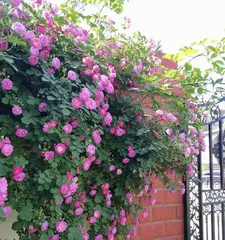Rose is a common flowering plant with beautiful flowers and a fragrant aroma, but after flowering, it often goes through a period of decline. To maintain the healthy growth and beautiful shape of the rose, proper pruning and care are necessary. This article will introduce how to prune and care for roses after they have finished blooming to help gardening enthusiasts better manage their rose gardens.

The correct pruning time
The appropriate pruning time is key to ensuring the healthy growth of roses. Pruning should be done in early spring or autumn after the flowers have withered, avoiding the hot summer. This allows the rose a better recovery period, enabling it to grow more healthily in the next growing season.
Remove withered and yellow leaves
When pruning, be sure to promptly remove any withered and yellow leaves from the rose. These leaves not only affect the rose's appearance but can also become breeding grounds for pests and diseases. Use scissors or pruning tools to carefully cut off these leaves, keeping the rose tidy.

Remove spent flowers
Spent flowers consume the rose's nutrients and affect the growth of the next wave of flowers. When pruning, all spent flowers should be removed. The scissors or pruning tool should be cut at a leaf node below the flower, which can promote the growth of new flower buds.
Prune dense branches
Overly dense branches can affect the rose's ventilation and light exposure, making it prone to pests and diseases. When pruning, pay attention to thinning out dense branches, maintaining appropriate spacing between them. Select some weaker branches to prune to promote balanced overall development.
Prune bent and crossing branches
Rose gardens often have some bent and crossing branches, which not only affect the overall aesthetics but may also compete for the rose's nutrients. When pruning, these bent and crossing branches should be removed to keep the rose upright and tidy.

Pay attention to the pruning angle
When pruning, a suitable angle should be chosen for the cut. Generally, the pruning angle should be consistent with the direction of the rose's growth. This can promote the growth of new branches and reduce the size of the wound, lowering the risk of pest and disease infestation.
Fertilizing and watering
Roses after blooming need appropriate fertilizing and watering to recover and grow. Choose a suitable organic fertilizer and apply it according to the instructions on the packaging. When watering, avoid overwatering or underwatering, keeping the soil moist but not waterlogged.
Loosening soil and weeding
To maintain the healthy growth of roses, regular loosening of the soil and weeding are necessary. Loosening the soil can improve soil aeration and water retention, promoting root development. Weeding reduces competition and provides a better growing environment for the roses.
Pest and disease control
Roses are susceptible to pests and diseases such as black spot and powdery mildew. To keep roses healthy, they should be regularly checked for signs of pests and diseases. Once detected, timely control measures should be taken, such as spraying pesticides or removing infected parts.
Maintain appropriate light exposure
Roses thrive in full sun, but excessive sunlight can cause leaf scorch. In the few days after pruning, the rose should be placed in a cool, ventilated spot to gradually adapt to the sun. Afterwards, it can be moved back to its normal growing environment.
Maintain air circulation
Roses need good air circulation to prevent pests and diseases and promote growth. After pruning, ensure there are no obstructions around the plant that hinder air flow. If planted in a shaded area, the obstructions should be pruned or adjusted in a timely manner.
Pay attention to temperature and humidity
Roses adapt to warm and humid climates, but excessive moisture can lead to the growth of pathogens. After pruning, avoid overwatering or overly humid environments. Maintaining suitable temperature and humidity is conducive to the healthy growth of roses.
Prevent frost damage
Roses are vulnerable to frost in cold weather. To protect them, they should be covered or moved indoors for insulation during the cold season. This can prevent the roses from being damaged by severe cold.
Regular pruning and maintenance
In addition to pruning after blooming, regular maintenance pruning is also necessary. Performing a light pruning in early spring or autumn each year helps maintain the health and beauty of the roses.
Pruning and care are crucial for maintaining the healthy growth of roses after they have finished blooming. Key points include the correct pruning time, removing withered and yellow leaves, removing spent flowers, pruning dense branches, pruning bent and crossing branches, paying attention to the pruning angle, fertilizing and watering, loosening soil and weeding, pest and disease control, maintaining appropriate light exposure, air circulation, temperature and humidity, preventing frost damage, and regular pruning and maintenance. Through proper pruning and care measures, we can enjoy the beauty and fragrance that roses bring.